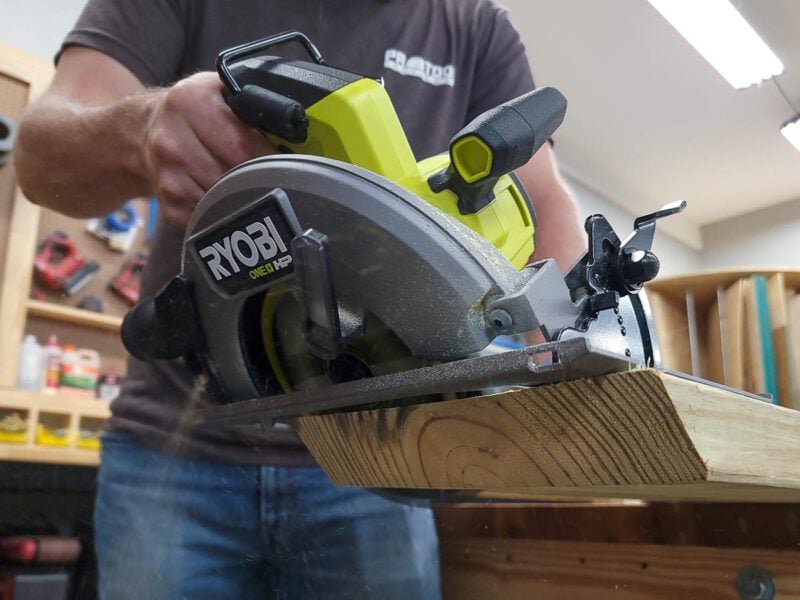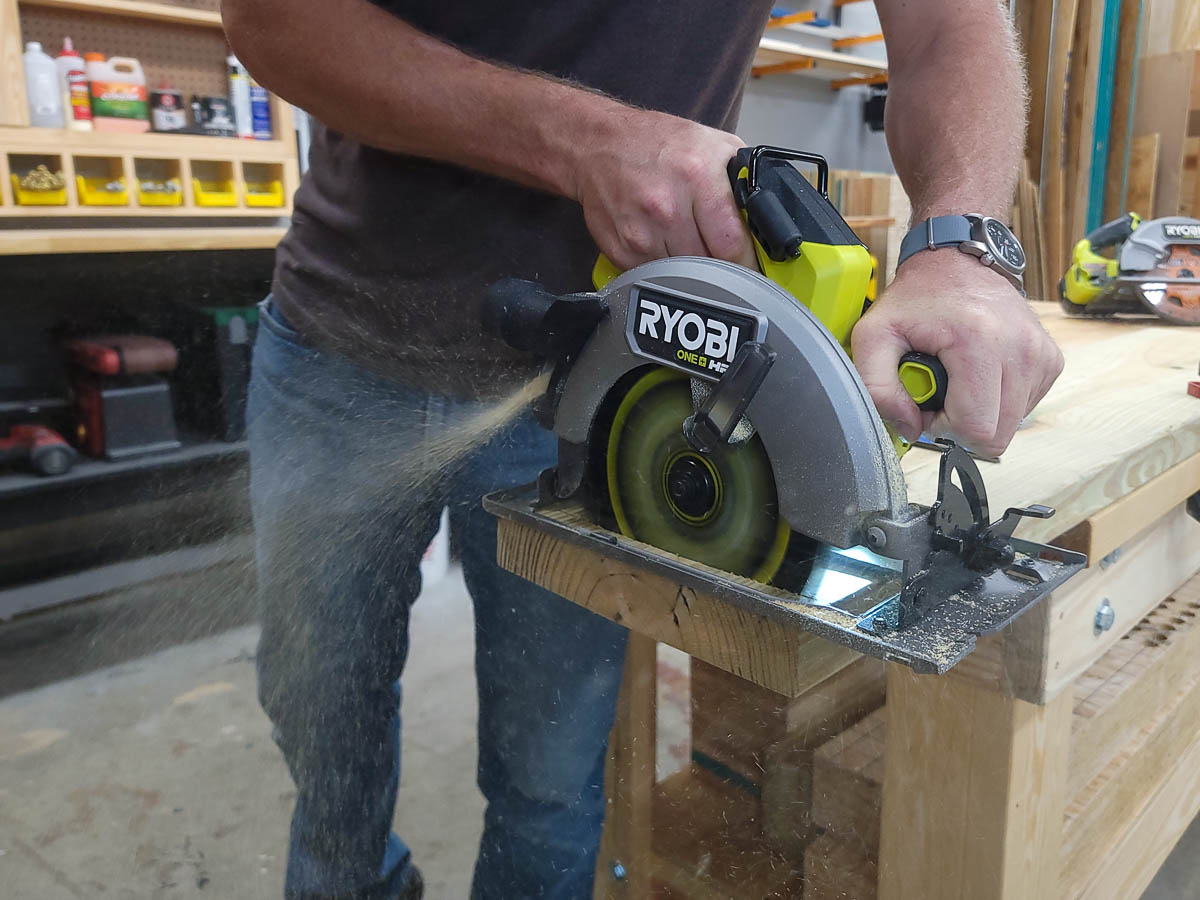Ryobi Introduces Its Strongest Cordless Circular Saw Ever
Cordless circular saws have come a long way in recent years, and Ryobi’s latest 18V brushless model promises to push things even further. We’re going to run through the key specs and features, then put it to the test here in our shop to see how it compares to the previous model, so you can decide if it’s the right tool for you!
Pros
- Improved cutting speed and power
- Excellent ergonomics
- Top-notch dust collection
- Folding rafter hook
Cons
- No significant drawbacks
Ryobi 18V One+ HP Brushless Circular Saw Performance

- No-load Speed: 5,000 RPM
- Blade Diameter: 7-1/4 in.
- Max Bevel: 56°
- Cut Depth at 90°: 2-9/16 in.
- Cut Depth at 45°: 1-13/16 in.
- Arbor: 5/8 in.
Cutting Power
The second-generation Ryobi HP Brushless circular saw is powered by a brushless motor that churns out up to 5,000 RPMs with a max cutting depth of 2-9/16 inches. This is a noticeable speed upgrade from the previous model (PBLCS300), which has a top speed of 4,300 RPMs.
During our testing, this saw plowed through a series of common cuts in our 2×10 PT test board. These included cross, bevel, and miter cuts. It did struggle slightly while making compound miter cuts, but that type of cut is typically reserved for roof and truss framing applications and is very demanding for any saw, so we’re not too upset.

Compared to the previous model, this saw exhibited much more cutting power, and we were able to really push the saw through the cuts without stalling the motor. Of course, stalling the motor is bound to happen sooner or later, but as long as you let the saw do the work and maintain RPMs, you’ll be good.
Upgrading to a premium thin kerf blade like Milwaukee’s Nitrus Carbide Framing and Demo blade will make it even better.
Depth and Bevel Adjustment
You won’t find any big surprises when looking at the cut depth and bevel adjustment, but Ryobi did make some excellent design upgrades in these two areas.
To adjust the cut depth, flip the lever on the back of the saw and position the shoe where you need it. The big upgrade here is that Ryobi moved the depth scale from the upper blade to an independent scale that sits between the tool body and blade guard. Moreover, it features high contrast white on black lettering, making it much easier to see versus the cast markings on the old model.

The process and design for adjusting the bevel are similar to those for adjusting the cut depth. Start by flipping the metal lever, then slide the shoe to your desired angle. There are bevel detents at 15°, 22.5°, and 45° for fast and accurate adjustments to common cut angles. Like the depth adjustment scale, Ryobi swapped out the plastic for metal and gave it the same high-contrast lettering for improved visibility.
Dust Collection

Ordinarily, I wouldn’t take an entire section to talk about something as trivial as a dust port, but I think Ryobi’s design team deserves a shoutout here. On the previous model, sawdust was directed out the back of the upper blade guard. The problem with this is that you end up with sawdust all over your shoes unless you use the vacuum adapter and dust extractor. But even then, the system wasn’t very effective and was prone to clogs.
The solution? Ryobi moved the chip ejection port to the side of the upper blade guard and redesigned the vacuum adapter to make it more efficient. They designed the adapter with a smaller ejection port so wood chips and sawdust can pass through when you’re not using a vacuum. This same port also allows outside air to be drawn in by your vacuum, acting almost like a cyclonic booster, leading to nearly 100% dust collection.
The beauty of this design is that you can leave your vacuum adapter permanently installed on your saw even when you don’t need or want to use a vacuum. This adapter is compatible with 1 1/4-inch and 1 7/8-inch hoses.
Ryobi 18V Brushless Circular Saw Design Notes

- Model: Ryobi PBLCS302
- Power Source: Ryobi 18V battery
- Weight: 8.3 lbs (bare tool), 9.8 lbs (with 4.0Ah Edge battery)
- Shoe Material:
- Guard Material:
Size and Weight
The Ryobi PBLCS302 weighs 8.3 pounds as a bare tool and 9.8 pounds with the recommended 4.0Ah Edge battery. What’s interesting is that this is about 1.3 pounds heavier than the previous model despite their similar profiles and feature set. This increase in weight is likely due to the larger motor and new metal components that replaced plastic ones.
Ergonomics
As I mentioned earlier, the overall profile of these tools is very similar, but there are some key changes that I want to point out.

Personally, I really like the overall feel of this saw. The grips are draped in a generous amount of rubber overmolding, and the spacing between the main grip and front pommel is vastly improved.
Moreover, the pommel grip is slightly offset, giving your arms more room to breathe during two-handed cuts.
Ryobi also added a folding rafter hook to this model—a feature that was greatly missed on the PBLCS300.
Additional Features
- Onboard hex wrench storage
- Compatible with all Ryobi 18V batteries
Ryobi 18V Brushless Circular Saw Model Comparison

| PBLCS300 (old) | PBLCS302 (new) | PSBCS01 (compact) | |
|---|---|---|---|
| No-Load Speed | 4,300 RPM | 5,000 RPM | 4,900 RPM |
| Cut Capacity at 90° | 2-7/16 in. | 2-9/16 in. | 2-1/4 in. |
| Cut Capacity at 45° | 1-3/4 in. | 1-13/16 in. | 1-9/16 in. |
| Bevel Capacity | 56° | 56° | 50° |
| Bare Weight | 7.0 lbs | 8.3 lbs | 5.5 lbs |
| Working Weight | 8.6 lbs w/4.0Ah High Performance battery | 9.8 lbs w/4.0Ah Edge battery | 7.1 lbs w/4.0Ah High Performance battery |
Ryobi 18V Brushless Circular Saw Price
As of the time of writing this, the Ryobi PBLCS302 retails for $139 as a bare tool and is covered by a 3-year limited warranty. The first-gen model originally sold for $129, but is currently on sale for $99. In our experience, this usually indicates that Ryobi is selling off its old stock to make way for the new tools. With that in mind, it’s a great time to scoop up the PBLCS300 for a heck of a deal!
The Bottom Line
After getting some hands-on time with the Ryobi PBLCS302, it’s clear that this is much more than a simple incremental upgrade. The overall ergonomics and feature set have improved dramatically, and the increased power and blade speed are welcomed changes. The overall performance level definitely exceeds what we expect from the DIY category, though it’s still not what you’ll experience from a full Pro-grade saw like the Milwaukee M18 Fuel 2834 in terms of raw power.
With that said, I believe this saw lands firmly in the Prosumer category. As we saw during our testing, the PBLCS302 has more than enough power to complete most common cuts without breaking a sweat. Not to mention, the $139 pricetag is hard to pass up for value-minded Pros and serious DIYers alike.
If you already have the first-gen PNLCS300 and are curious if you should upgrade, there are a couple of things to consider. This new model is certainly faster and more powerful, but if you’re still happy with the first-gen model, I don’t see a justifiable reason to spend the extra cash. On the other hand, if you find yourself wishing you had more power on your cuts, this model brings you the upgrade you need.



